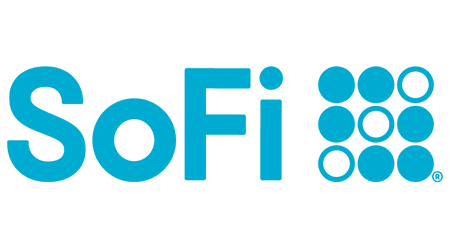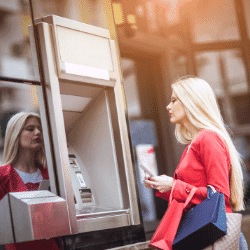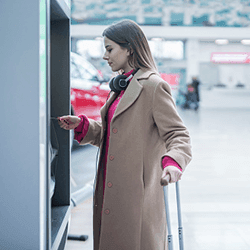
- 0.50% APY on checking balance
- Up to 3.80% APY on savings
- $0 account or overdraft fees
- Get up to a $300 bonus with direct deposits of $5,000 or more


Use this table to compare accounts by fees, interest and ATM access.
The Finder Score crunches over 300 checking accounts from hundreds of financial institutions. It takes into account the product's monthly fees, overdraft fees, opening deposit, customer support options, ATM network and features — this gives you a simple score out of 10.
To provide a Score, Finder’s banking experts analyze hundreds of checking accounts against what we consider is the best option: no monthly fees, no overdraft fees, a large ATM network of 50,000 or more, additional features outside of typical banking services, and the optional perk of earning interest. Accounts that are nearly free to maintain and use are scored the highest, while accounts with costly fees and few features are scored the lowest.
While most debit cards do the same thing, features may vary based on the bank or credit union and the type of account it’s linked to. How you plan on using the card will determine which features are most important:
A cashback debit card earns cash-back rewards when you use it to purchase goods or services. Cashback debit cards aren’t nearly as common as cash-back credit cards, though there are a few to choose from. Two of the most popular cashback debit cards are the Discover Cashback Debit card and the Axos CashBack Checking account debit card.
Debit cards are linked to a bank account and allow you to shop in stores or online, withdrawing purchases from your own balance of funds.
To use a debit card, you need a linked account to draw money from and a PIN.
In some cases, the cashier or card reader may ask if you want to use your card as a debit or credit card. If you use it as a credit card, you may need to provide a signature to verify your identity.
Whichever option you choose, you need enough money in your account before you can use your card. A debit card doesn’t give you a line of credit, even if you use it as a credit card. For the most part, there’s not much of a difference between using your card as a debit or credit card.
When you buy something in-person, you have the option to run your card as credit or debit. If you run it as debit, you’ll enter your PIN and the money will be taken out of your account immediately. You’ll also have the option to get cash back if the merchant allows it.
If you use it as credit, you’ll sign for the purchase. The payment is then processed through the credit card network and withdrawn from your account within a couple of days. Running your card as credit usually gives you the same anti-fraud protection that comes with credit cards, but check with your bank to be sure.
You should use a debit card because it’s safer than carrying around cash and easier than paying with a check. Debit cards are also issued by major credit card providers — including Visa and Mastercard — which means they can be used everywhere credit cards are accepted. However, paying with a credit card is safer than paying with a debit card because credit card companies often provide fraud and purchase protection. If someone steals your credit card information, they aren’t taking your actual money.
Use your debit card to withdraw cash from your account at participating ATMs:
With your debit card, you can also deposit checks, review your account balance or transfer money from linked accounts.
Back to topThis table showcases the major differences between debit cards, credit cards, prepaid debit cards and ATM cards.
| Type of card | Best for | Earns rewards | Can use at ATMs | Builds credit |
|---|---|---|---|---|
Debit card | Those who want to use money from their checking account | Sometimes | ||
Credit card | Those who want to build their credit score using a revolving line of credit | |||
Prepaid debit card | Those with no credit, bad credit or a bad banking history | Sometimes | ||
ATM card | Those who want to withdraw cash from their savings accounts |
Debits cards offer several advantages over other payment methods, but they have some drawbacks as well.
There are four types of debit cards on the market. While all debit cards allow you to make purchases, each type has different functions, features and security measures.
To get a debit card, open a checking account at a bank of your choice. Some banks will automatically send you a debit card; with others, you’ll have to request your card.
Once you receive your debit card, follow the included instructions to activate your card. Your bank will provide you with a pre-selected PIN and instructions on how to change it.
Typically, you have to be at least 18 years old to get a debit card, though some states only require you to be 16 and others require you to be 19. Many banks also offer debit cards for kids as young as 13, but only if they open a joint bank account with a parent or guardian. Other options for kids are prepaid debit cards that come with chores and allowance tracking features.
Yes, you can ask for additional cards (typically up to two cards) for family members or business associates, but as the primary account holder, you will still be responsible for any actions taken using those cards.
You can link almost any everyday checking account to a debit card. You need an account and routing number and the account must be in the same name as what’s on the card. It can also be a joint account if desired.
The Card Verification Value (CVV) is a three-digit number found on the back of your Discover, Mastercard or Visa debit card. On American Express debit cards, the CVV is four digits. This number is used to verify your debit card and helps to reduce fraud, by proving to the merchant that you have the physical debit card with you when making a purchase online or over the phone.
Back to topOne way debit card companies make money is by charging fees. There are some ways to avoid bank fees, but you might not be able to dodge all of them. Aside from monthly maintenance fees tied to a checking account, here are common fees for debit cards.
A surcharge is an additional amount a business charges when you pay for a purchase using your debit card rather than another payment method — for example, cash. When you buy goods or services using a debit, credit or prepaid card, the merchant typically incurs its own processing costs on your payment. Many merchants consider these fees the cost of doing business, while others pass along the fee to the customer by imposing a surcharge on card-based transactions.
No. Surcharges and minimum purchase requirements are legal for credit cards only. And even then, only under specific conditions. This restriction applies even if you use a debit card after selecting “credit” on a point-of-service terminal.
Businesses are unable to get around the law by giving surcharges a different name, like handling or service fees. Report merchants charging you a surcharge on a debit card purchase to the card-processing networks.
Debit card fees are inconvenient, but it’s possible to avoid them by following these tips.

Fee schedules, amounts and charges vary by bank and account. Compare multiple options to find an account with reasonable or no fees.

Switch to e-statements to reduce fees, help the environment — and avoid paper statement fees.

There’s a good chance you’ll be charged for using an out-of-network ATM, so try to stick with your bank’s ATMs. Or find an account that doesn’t charge out-of-network ATM fees.

If possible, leave your card at home when traveling abroad. Instead, take out cash before you leave for a trip, use a prepaid travel card or sign up for a credit card that rewards you for worldwide travel.

Many banks waive monthly and other fees if you meet certain conditions, like maintain a minimum account balance. Narrow down an account by searching for conditions you can meet.

Fees for overdrafts and nonsufficient funds can be expensive. Keep an eye on your balance to avoid transactions that will take it below zero.

Surcharges on debit cards are illegal. Don’t be afraid to tell the retailer that it’s not allowed and you’ll take your business elsewhere.

If you wait to report a lost or stolen debit card, you increase your chances of fraudulent activity, and you could be held liable for some charges because you waited to make a report.
Debit card fraud happens when someone illegally obtains your card information and uses it to make purchases. You usually don’t know it’s happened until you see unusual activity on your bank statement. It’s important to notify your bank as soon as you see fraudulent charges, so they can deactivate your card and send you a new one.
This depends on your bank and the situation. Many of the bigger banks offer a 100% money-back guarantee on fraudulent transactions if you comply with the card’s conditions of use. For more information, speak to your financial institution.
You will need to contact the bank or financial institution that issued the card as soon as possible to find out why the card has been blocked.Back to top
Debit cards are a convenient way to make purchases and manage your cash. But depending on your bank, you could end up paying a fee to use yours. Keep an eye on your balance and understand the terms and conditions for your card to avoid paying more than necessary. To find a card with lower fees or better convenience, compare your debit card options against your needs and lifestyle.
The Fizz card could help you build credit without excessive debt, annual fees or interest charges.
The Affirm Debit+ card lets you split your purchases into four interest-free installments.
The popular P2P app offers a no-fee debit card with cashback rewards.
SoFi, Discover, Chime, Varo, Revolut and Capital One are the best international debit cards for travel with $0 foreign transaction fees.